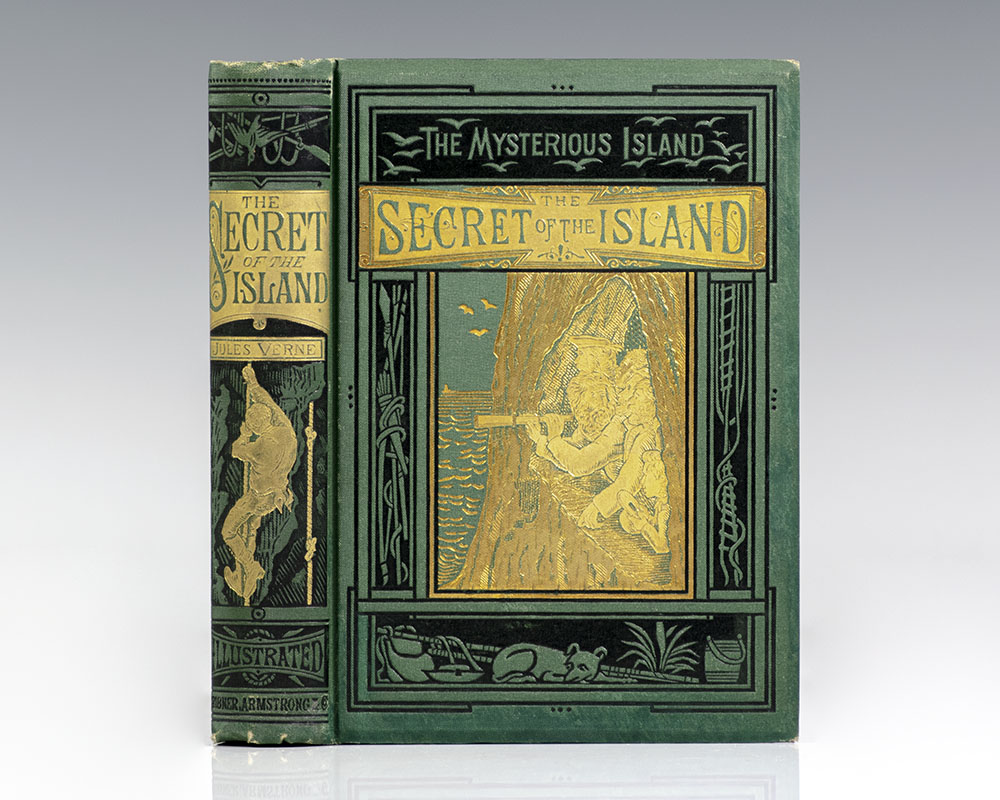Twenty Thousand Leagues Under the Seas.
"THE SEA IS ONLY THE EMBODIMENT OF A SUPERNATURAL AND WONDERFUL EXISTENCE": Exceedingly rare true first edition of Jules Verne's Twenty Thousand Leagues Under the Seas
Twenty Thousand Leagues Under the Seas.
VERNE, Jules.
$37,500.00
Item Number: 146922
London: Sampson, Low, Marston, Low, & Searle, 1873.
Scarce first English edition, preceding the first American edition, of Verne’s masterpiece. Octavo, original publisher’s pictorial blue cloth stamped in black and gilt by Burn & Co., with the binder’s ticket on rear pastedown, all edges gilt, illustrated with 112 splendid full-page woodcut illustrations after drawings by renowned French illustrators Alphonse-Marie de Neuville and Edouard Riou, 8-pp. publisher’s advertisements at rear headed “For the Season 1872-3.” Originally published in France in 1869, Twenty Thousand Leagues Under the Seas has a complex publishing history in the English language. The novel was originally serialised from March 1869 to June 1870 in Pierre-Jules Hetzel’s French fortnightly periodical, the Magasin d’éducation et de récréation. A deluxe octavo edition, published by Hetzel in November 1871, included 111 illustrations by Alphonse de Neuville and Édouard Riou. The title of the story refers to the distance travelled under the various seas: 20,000 metric leagues (80,000 km, over 40,000 nautical miles), nearly twice the circumference of the Earth. The first English translation of the novel was published by Sampson Low in London in late 1872 (but dated 1873). In November 1872, James R. Osgood published the first American edition in Boston using the sheets from the London edition and with a new title page. George M. Smith published a second American edition shortly after in a format and binding very similar to the Osgood edition, and, curiously, with the imprint “Edition of James R. Osgood” on the title page. For an unknown reason, copies of Osgood’s first American edition became unavailable almost immediately following publication. There is some speculation that only a small number of copies were printed, the majority of which were destroyed in the Great Boston Fire of November 9th 1872. It estimated that as few as 50 to 100 copies of the Osgood edition may still exist today in green, brown and blue cloth. In very good condition. Provenance: small bookplate of Claude F. Walker to the pastedown. Housed in a custom full morocco clamshell box. A nice example of one of the rarest and most difficult highspots to obtain in 19th century literature.
The famous tale of Captain Nemo and his submarine the Nautilus, “Twenty Thousand Leagues owed much to the exploits of the huge experimental French submarine Le Plongeur and to the work of Verne’s friend Jacques-François Conseil, who developed a steam-driven submarine and whose surname Verne gave to Professor Arronax’s servant in the story” (Carpenter and Prichard, 557). Verne combined science and invention with fast-paced adventure. Some of Verne's fiction has also become fact: his submarine Nautilus predated the first successful power submarine by a quarter century, and his spaceship predicted the development a century later. The first all-electric submarine, built in 1886, was named Nautilus in honor of Verne's vessel. The first nuclear-powered submarine, launched in 1955, was named Nautilus, too. The film version was produced by Walt Disney in 1954 and directed by Richard Fleischer, won an Oscar for its special effects.
















